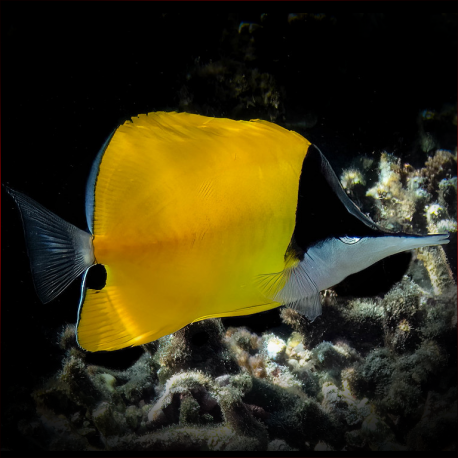More info
Datasheet
| Minimum Tank Size | 400 litres / 105.67 US gallons |
| Maximum Size | 22.0cm / 8.66inches |
| Reef Compatible | Often reef safe |
| Temperament | Mostly peaceful but might be aggressive towards similar species |
| Temperature | 22.2°C / 71.96°F - 25.6°C / 78.08°F |
| Specific Gravity | 1.020-1.025 |
| Carbonate Hardness | 8-12 |
| pH | 8.1-8.4 |
General Description
The Longnose butterflyfish (Forcipiger flavissimus) is a striking species belonging to the Chaetodontidae family, commonly known by various names including Yellow longnose butterfly, Long-nosed coralfish, and Forcepsfish. It can be distinguished from similar species by its shorter snout and the white area on the lower part of its eye.
Aquarium Suitability
This species, though suitable for aquariums, requires careful attention due to its fastidious feeding habits. It is an average hardiness fish that feeds slowly and selectively, needing a varied diet multiple times a day, especially when newly introduced. The Longnose butterflyfish can be initially shy in a new aquarium and tends to thrive best when housed without other members of the same species. It is often peaceful but may display aggressiveness towards similar species.
Care and Hardiness
This fish is average in hardiness and can be challenging to acclimatize and get feeding. It is vital to acquire healthy specimens to avoid potential problems related to acclimatization. Ensure the fish does not have parasites or visible infections and that its diet includes larger crustaceans, other invertebrates, small crustaceans, and zooplankton.
Reef Suitability
The Longnose butterflyfish is often considered reef-safe and can thrive in reef aquariums. However, it has been reported to nibble at clams, including Tridacna species, and may also consume tubeworms. Therefore, caution is advised when keeping this species in a reef setting.
Aquarium Setup
When setting up an aquarium for the Longnose butterflyfish, ensure a minimum tank size of 400 liters with stable water conditions including a pH of 8.1-8.4, a specific gravity of 1.020-1.025, a temperature range of 22.2-25.6°C, and a carbonate hardness (KH) of 8-12. Incorporate ample hiding spots to accommodate the initial shyness of the fish.
Behaviour
These fish generally ignore most other tank mates and are peaceful community members. To reduce potential aggression, more assertive fish should be introduced after the Longnose butterflyfish has acclimatized. They may benefit from a well-established aquarium containing an abundance of micro-life such as copepods and amphipods for foraging.
Feeding and Diet
The Longnose butterflyfish thrives on a diet consisting of larger crustaceans, other invertebrates, small crustaceans, and zooplankton. They are known to eat glass anemones (Aiptasia) but can be selective feeders, requiring patience and variety in their diet. The presence of their natural food sources in the aquarium can reduce the frequency of feedings needed.
Dimorphism
Information on dimorphism and captive reproduction of the Longnose butterflyfish is not provided.
Habitat and Distribution
These colorful fish are native to the Indo-Pacific region, found from the Red Sea and East Africa to the Hawaiian and Easter Islands, and north to southern Japan and south to Lord Howe Island and Micronesia. They can also be spotted in the eastern Pacific, from southern Baja California, Mexico, to the Revillagigedo and Galapagos Islands.

